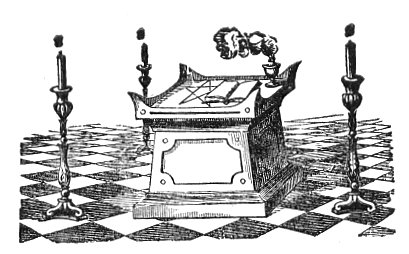So, in their language, gold and silver are the King and Queen, or the Sun and Moon; Sulphur, the flying Eagle; Mercury, the Man-woman, winged, bearded, mounted on a cube, and crowned with flames; Matter or Salt, the winged Dragon; the Metals in ebullition, Lions of different colors; and, finally, the entire work has for its symbols the Pelican and the Phœnix.
The Hermetic Art is, therefore, at the same time a religion, a philosophy, and a natural science. As a religion, it is that of the Ancient Magi and the Initiates of all ages; as a philosophy, we may find its principles in the school of Alexandria and the theories of Pythagoras; as a science, we must inquire for its processes of Paracelsus, Nicholas Flamel, and Raymond Lulle.
The Science is a real one only for those who admit and understand the philosophy and the religion; and its process will succeed only for the Adept who has attained the sovereignty of will, and so become the King of the elementary world: for the grand agent of the operation of the Sun, is that force described in the Symbol of Hermes, of the table of emerald; it is the universal magical power; the spiritual, fiery, motive power; it is the Od, according to the Hebrews, and the Astral light, according to others.
p. 775
Therein is the secret fire, living and philosophical, of which all the Hermetic philosophers speak with the most mysterious re-serve: the Universal Seed, the secret whereof they kept, and which they represented only under the figure of the Caduceus of Hermes.
This is the grand Hermetic arcanum. What the Adepts call dead matter are bodies as found in nature; living matters are substances assimilated and magnetized by the science and will of the operator.
So that the Great Work is more than a chemical operation; it is a real creation of the human word initiated into the power of the Word of God.
The creation of gold in the Great Work is effected by transmutation and multiplication.
Raymond Lulle says, that to make gold, one must have gold and mercury; and to make silver, silver and mercury. And he adds: “I mean by mercury, that mineral spirit so fine and pure that it gilds even the seed of gold, and silvers that of silver.” He meant by this, either electricity, or Od, the astral light.
The Salt and Sulphur serve in the work only to prepare the mercury, and it is to the mercury especially that we must assimilate, and, as it were, incorporate with it, the magnetic agent. Paracelsus, Lulle, and Flamel alone seem to have perfectly known this mystery.
The Great Work of Hermes is, therefore, an operation essentially magical, and the highest of all, for it supposes the Absolute in Science and in Will. There is light in gold, gold in light, and light in all things.
The disciples of Hermes, before promising their adepts the elixir of long life or the powder of projection, advised them to seek for the Philosophal Stone.
The Ancients adored the Sun, under the form of a black Stone, called Elagabalus, or Heliogabalus. The faithful are promised, in the Apocalypse, a white Stone.
This Stone, says the Masters in Alchemy, is the true Salt of the philosophers, which enters as one-third into the composition of Azoth. But Azoth is, as we know, the name of the grand Hermetic Agent, and the true philosophical Agent: wherefore they represent their Salt under the form of a cubical Stone.
The Philosophal Stone is the foundation of the Absolute philosophy, the Supreme and unalterable Reason. Before thinking of
p. 776
the Metallic work, we must be firmly fixed on the Absolute principles of Wisdom; we must be in possession of this Reason, which is the touchstone of Truth. A man who is the slave of prejudices will never become the King of Nature and the Master of transmutations. The Philosophal Stone, therefore, is necessary above all things. How shall it be found? Hermes tells us, in his “Table of Emerald,” we must separate the subtile from the fixed, with great care and extreme attention. So we ought to separate our certainties from our beliefs, and make perfectly distinct the respective domains of science and faith; and to comprehend that we do not know the things we believe, nor believe anything that we come to know; and that thus the essence of the things of Faith are the unknown and indefinite, while it is precisely the contrary with the things of Science. Whence we shall conclude, that Science rests on reason and experience, and Faith has for its bases sentiment and reason.

Moe is the founder of GnosticWarrior.com. He is a father, husband, author, martial arts black belt, and an expert in Gnosticism, the occult, and esotericism.





